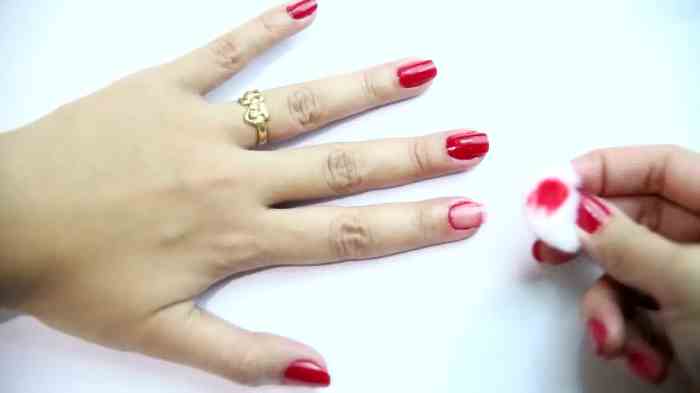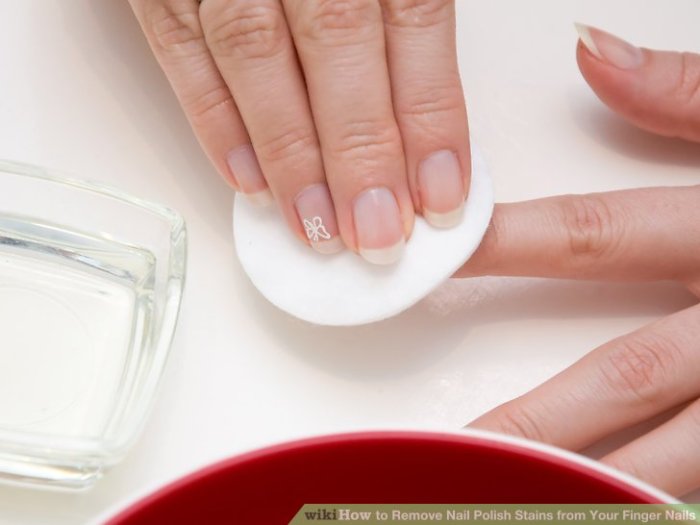How to Remove Nail Polish Stains From Fingernails
Understanding Nail Polish Stains: How To Remove Nail Polish Stains From Fingernails

Source: wikihow.com
How to remove nail polish stains from fingernails – Nail polish stains on fingernails result from the interaction of the polish’s chemical components with the keratin in the nail. The intensity of the stain depends on several factors, including the polish’s color, the application method, and the duration of exposure.
Nail Polish Composition and Staining
Nail polish typically contains a mixture of solvents, resins, pigments, and plasticizers. The pigments, which provide color, are often the primary culprits in staining. Solvents help the polish flow smoothly, while resins create a durable film. Plasticizers enhance flexibility. Darker colors, with their higher pigment concentration, tend to stain more intensely than lighter shades.
The solvents can also penetrate the nail plate, allowing pigments to embed themselves within the keratin structure.
Factors Influencing Stain Intensity
Several factors influence how deeply nail polish stains the nails. The concentration of pigments in the polish directly impacts staining; darker colors, naturally, stain more readily. The length of time the polish remains on the nails is another critical factor; longer exposure increases the chance of staining. Application method also plays a role; sloppy application can lead to polish seeping under the nail’s free edge, increasing staining.
Common Nail Polish Types and Staining Potential
| Color | Brand | Type | Staining Severity |
|---|---|---|---|
| Dark Red | Brand A | Gel Polish | High |
| Light Pink | Brand B | Regular Polish | Low |
| Deep Blue | Brand C | Gel Polish | Medium |
| Bright Orange | Brand D | Regular Polish | Medium |
Home Remedies for Stain Removal
Several home remedies can effectively remove nail polish stains, often utilizing readily available household items. The effectiveness varies depending on the stain’s age and severity. Always test any remedy on a small, inconspicuous area of the nail first to check for any adverse reactions.
Effective Home Remedies
- Lemon Juice: The citric acid in lemon juice helps to break down the pigment molecules in the stain. Apply fresh lemon juice directly to the stained area, let it sit for 10-15 minutes, and gently scrub with a soft-bristled brush.
- Baking Soda Paste: Create a paste of baking soda and water. Apply it to the stained area, gently scrub, and rinse. The abrasive nature of baking soda helps to lift the stain.
- Hydrogen Peroxide: Hydrogen peroxide’s bleaching properties can lighten nail stains. Apply a small amount to the stained area, let it sit for a few minutes, and then rinse thoroughly. Use caution, as it can bleach natural nail color if overused.
- Toothpaste (Whitening): The abrasive and bleaching agents in whitening toothpaste can help remove surface stains. Gently rub a small amount onto the stained area, then rinse thoroughly.
- White Vinegar: The acidity of white vinegar can help dissolve some nail polish pigments. Soak your nails in a diluted white vinegar solution for 10-15 minutes, then gently scrub with a soft brush.
Mechanism and Comparison of Home Remedies
The effectiveness of these remedies relies on different mechanisms. Lemon juice and white vinegar use acidity to break down pigments, while baking soda uses gentle abrasion. Hydrogen peroxide acts as a bleaching agent, and whitening toothpaste combines abrasion and bleaching. The safety and effectiveness vary; lemon juice and white vinegar are generally safe, while hydrogen peroxide should be used cautiously.
Baking soda and whitening toothpaste are abrasive, so gentle application is crucial.
Professional Nail Care Treatments
For stubborn stains that resist home remedies, professional treatments offer more powerful solutions. These treatments typically involve specialized products and techniques to remove deeply embedded pigments.
Professional Stain Removal Treatments

Source: wikihow.com
| Treatment | Cost | Effectiveness | Side Effects |
|---|---|---|---|
| Professional Nail Buffing | $20-$40 | Medium to High (depending on stain severity) | Potential for thinning of the nail if overdone |
| Chemical Exfoliation | $30-$60 | High | Possible irritation or dryness |
| Nail Whitening Treatments | $40-$80 | High | Rare, but potential for allergic reactions |
Prevention Strategies
Preventing nail polish stains involves careful application techniques and the use of protective layers. A well-executed manicure minimizes the risk of staining.
Minimizing Nail Polish Staining, How to remove nail polish stains from fingernails
Using a base coat creates a barrier between the nail and the colored polish, reducing pigment penetration. A top coat seals the colored polish, preventing chipping and reducing the chance of the polish seeping under the nail’s free edge. Proper application techniques are key; apply thin coats to avoid pooling, and clean up any spills immediately. Avoid prolonged exposure to the polish by removing it promptly.
Persistent nail polish stains around your cuticles can be tricky, often requiring gentle scrubbing with a soft brush and nail polish remover. However, if your remover is thick and ineffective, you might need to address the polish itself first; check out this guide on how to fix nail polish that is dry for some helpful tips. Once you’ve revitalized your polish, tackling those stubborn stains will be much easier, leaving your nails looking their best.
Illustrative Examples
An unstained fingernail appears smooth, with a natural, translucent pink or beige hue. The texture is even and consistent. A stained fingernail, in contrast, might exhibit discoloration, ranging from faint yellowing to intense dark hues depending on the polish color. The texture might appear slightly rougher in severely stained areas.
Severely Stained Fingernail Description
A severely stained fingernail might display a deep, persistent discoloration, potentially extending under the free edge of the nail. The color might be uneven, with darker areas concentrated where the polish had pooled. The texture could feel rougher or slightly pitted. This level of staining likely results from prolonged exposure to dark-colored polish, combined with improper application and removal techniques.
Post-Treatment Appearance
After successful stain removal using lemon juice, for example, a previously stained fingernail might appear lighter, with the discoloration significantly reduced or eliminated. The texture might still be slightly rough depending on the severity of the original stain, but the overall appearance is improved, returning to a smoother and more natural look.
Dealing with Persistent Stains
Home remedies might prove ineffective against deeply embedded or long-standing stains. In such cases, professional intervention is necessary.
Persistent Stain Management
- Assess the severity of the stain. If home remedies have failed after multiple attempts, professional help is advisable.
- Schedule an appointment with a nail technician or dermatologist.
- Describe the stain’s characteristics and the attempted home remedies to the professional.
- Follow the professional’s recommended treatment plan.
- Maintain proper nail hygiene to prevent future staining.
Expert Answers
Can I use acetone to remove nail polish stains?
While acetone is effective at removing nail polish, it can also dry out and damage your nails. Use it sparingly and always follow up with a moisturizing treatment.
How long should I leave a home remedy on my nails?
The application time varies depending on the remedy. Follow the instructions for each specific method. Generally, avoid leaving any treatment on for extended periods to prevent irritation.
What if the stain is under my nail?
Stains under the nail are more challenging to remove. Gentle scrubbing with a soft brush and a mild solution might help, but stubborn stains may require professional attention.
















